It’s been a long time since I’ve written a blog so apologies for this. For several months I was bogged down in a research project for the finance company that I work for on a part time basis. This culminated in a grueling two month global marketing trip, something that won’t be repeated again if only for the sake of my health – it really did me in and included bursting the blood vessels in one of my eyes. For three weeks I looked like a gruesome extra from a horror movie. I felt even worse for the clients who had to sit opposite me and literally look me in the eye during my endless presentations.
Anyway that’s all behind me and to be fair it hasn’t all been work as I have managed a few photographic trips over the course of the year. There’s probably enough ammunition for a number of blogs but I’m going to start with the place where I have spent more time photographing than any other over the last 15 years – East Africa. In 2013 I made three short trips there – two to Kenya and one to the central Serengeti in Tanzania. Normally my East African trips are timed to coincide with the annual Wildebeest migration but this year, partly due to work commitments, all of them fell outside of this “peak season”. The other reason is that I have pretty much given up fighting with the hordes of vehicles that now populate the Mara in August and September. Hence my trips to the Mara were in March and mid-November and to the Serengeti in May. Many would associate these “low season” trips with sub-optimal game viewing but with the right guide, local knowledge and a little luck, the low season can be every bit as rewarding as the high season. Indeed my recent Mara trip in mid-November was arguably my best ever in more than 30 such visits.
The primary reason for this was that due to a paucity of rain in the Serengeti, the Wildebeest have lingered on in the Mara far longer than normal. As a result, I spent much of my time following the herds which especially towards the end of my visit, were moving rapidly en masse in the general direction of the Mara River in and around the Lookout landmark in the south Mara. Herd numbers were as large as anything that I have seen during “peak” migration periods.
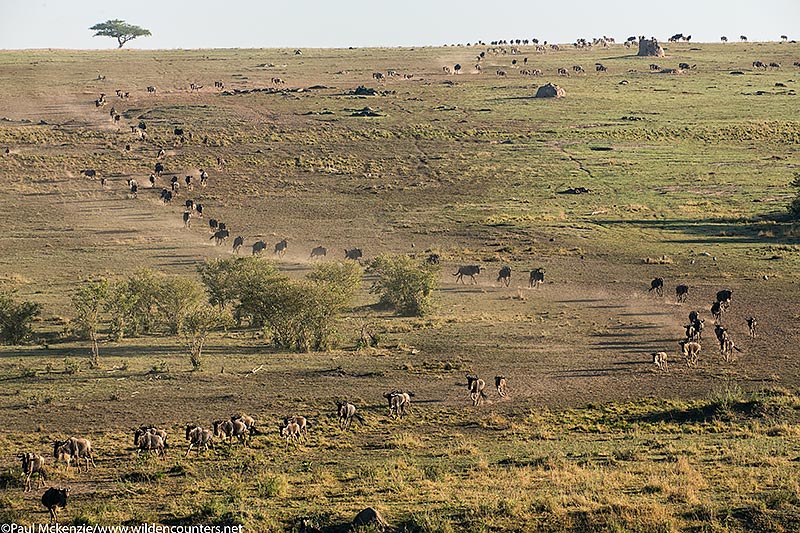
Migrating Wildebeest in S shape curve, Masai Mara, Kenya
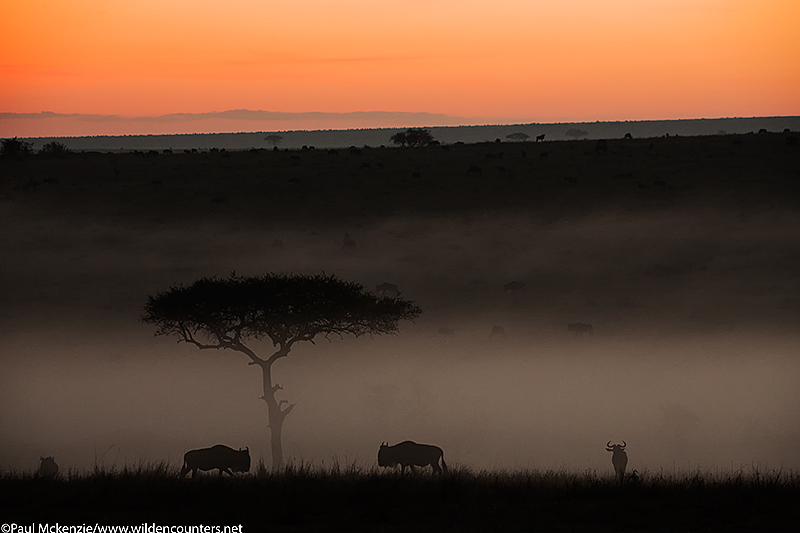
Wildebeest at dawn in the mist, Masai Mara, Kenya
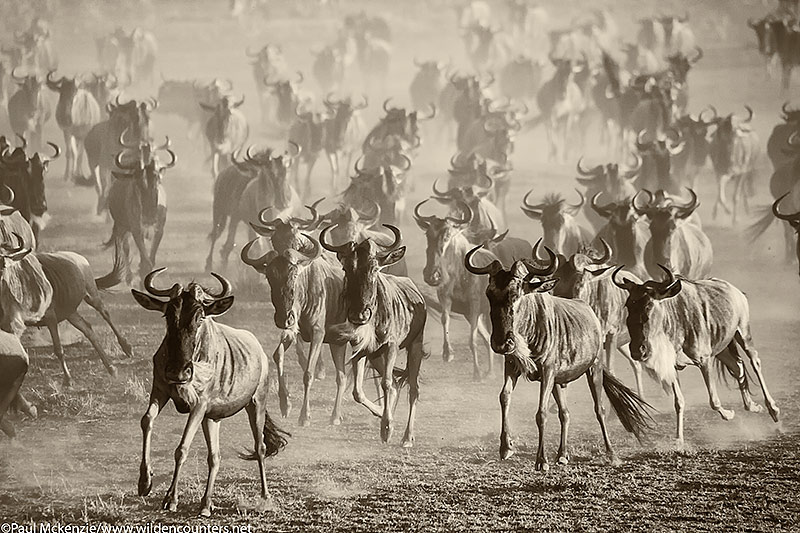
Wildebeest herd running, Masai Mara, Kenya
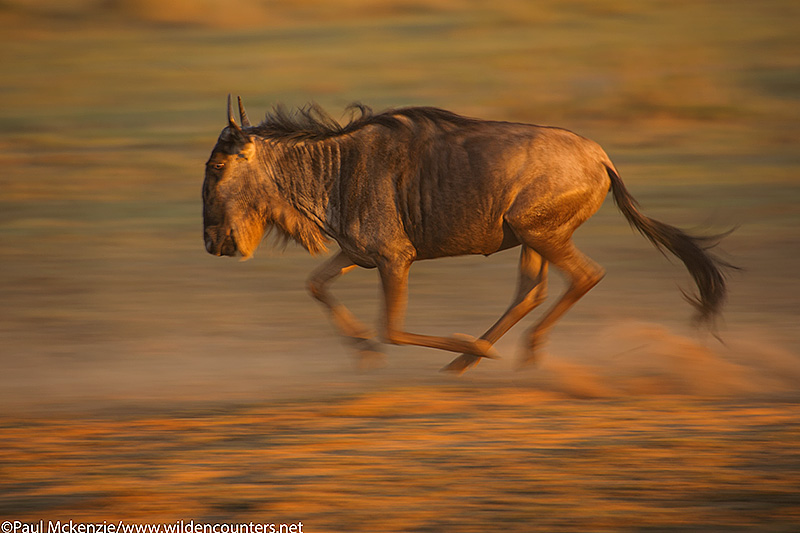
Wildebeest running, with motion, early morning, Masai Mara, Kenya
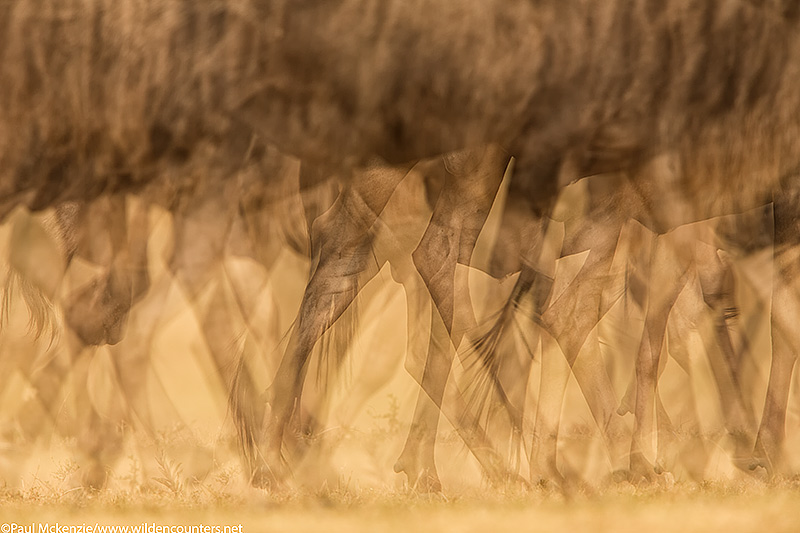
Wildebeest legs, in-camera multiple exposure, Masai Mara, Kenya
When I went to the Serengeti in May I bought along my rock cams (plastic casings disguised as rocks in which I place cameras and which I trigger manually from a vehicle some distance away using wireless remotes). Although the casings blend in well with the environment, they have several failings not least being their inflexibility – i.e. once down, they cannot be manoevered. Perhaps more importantly, they are prone to “attack” by some of the larger cats. Lions in particular, tend to mistake them for Leopard Tortoises, an irresistible target. The camera lens protrudes very slightly out of the casings and this usually invites copious amounts of licking. Indeed the single biggest problem I have when using the casings with large cats and especially Hyenas is excessive amounts of saliva on the front element of the lens. What often happens is that the window for decent images is literally a second or two before the lens is fogged up with saliva. I can’t tell you how many images I have similar to the following ones.
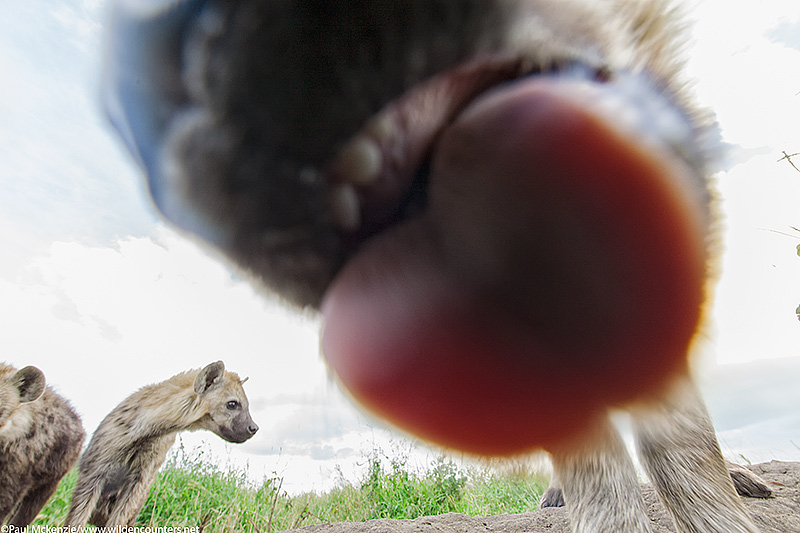
Close-up of Hyena tongue and mouth as it licks the camera lens, Seronera, Tanzania
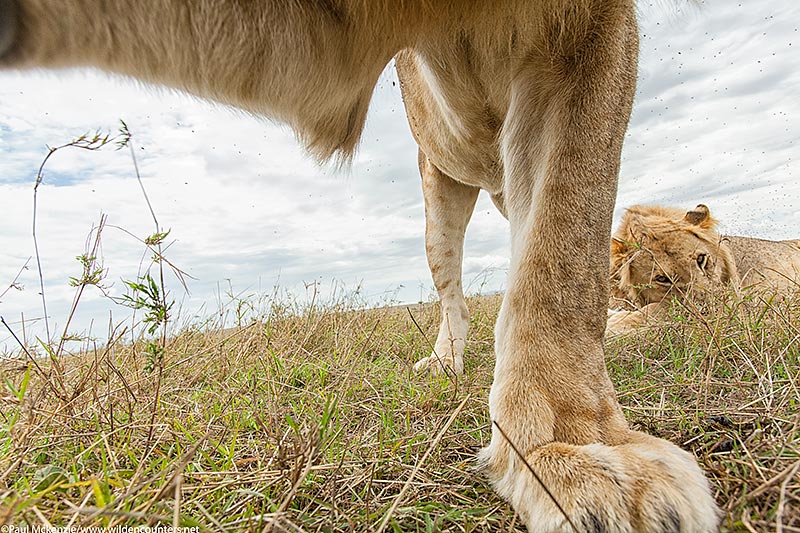
Inquisitive young male Lion, close-focus, wide-angle, Masai Mara, Kenya
So one has to be quick and lucky to get any acceptable images.
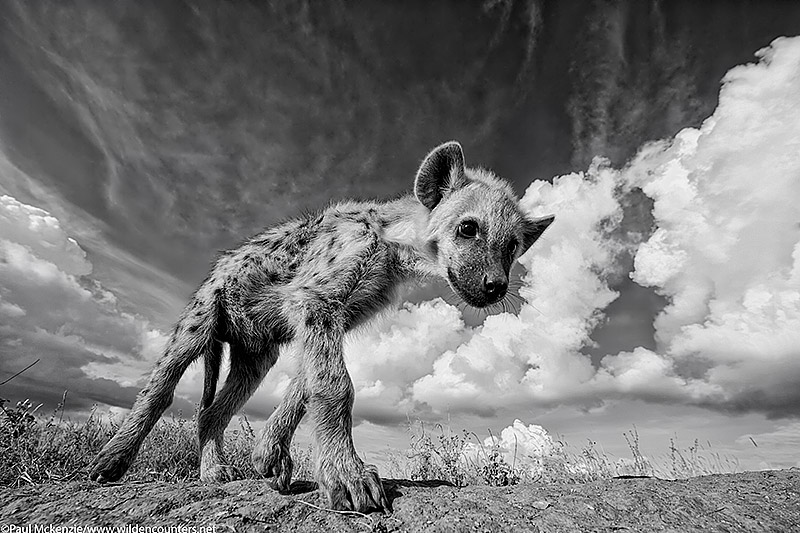
Juvenile Spotted Hyena, close-focus, wide-angle, Serengeti, Tanzania
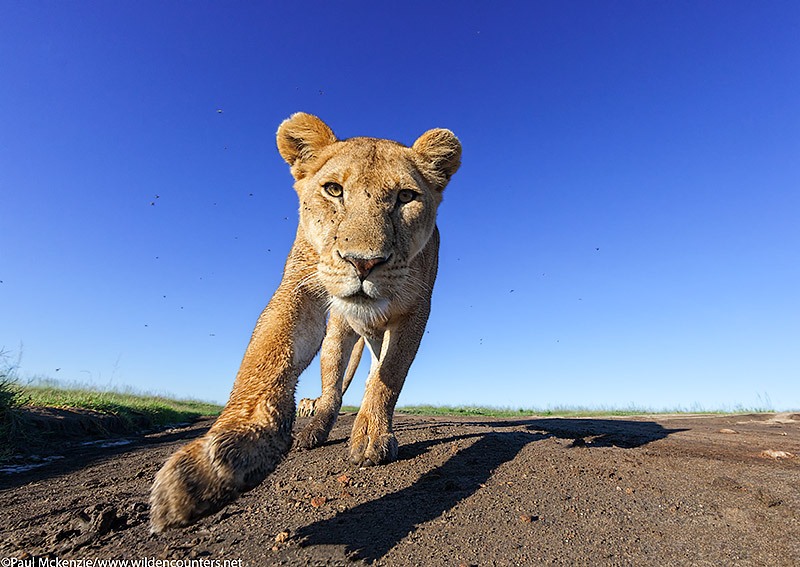
Lioness walking, head on, close-focus, wide-angle, Serengeti, Tanzania
The better solution is to use a sturdier casing (metal) that moves. My new toy is a modified remote control buggy with a metal casing for the camera. I only had limited opportunities to use this on my most recent trip (basically you have to be on your own) but the results were quite encouraging. The Lions are initially very curious – stepping on it, attempted biting and even picking it up (it’s pretty heavy) but the ability to move it around is a huge advantage. After a while they lose interest in it and this is when the best opportunities arise.
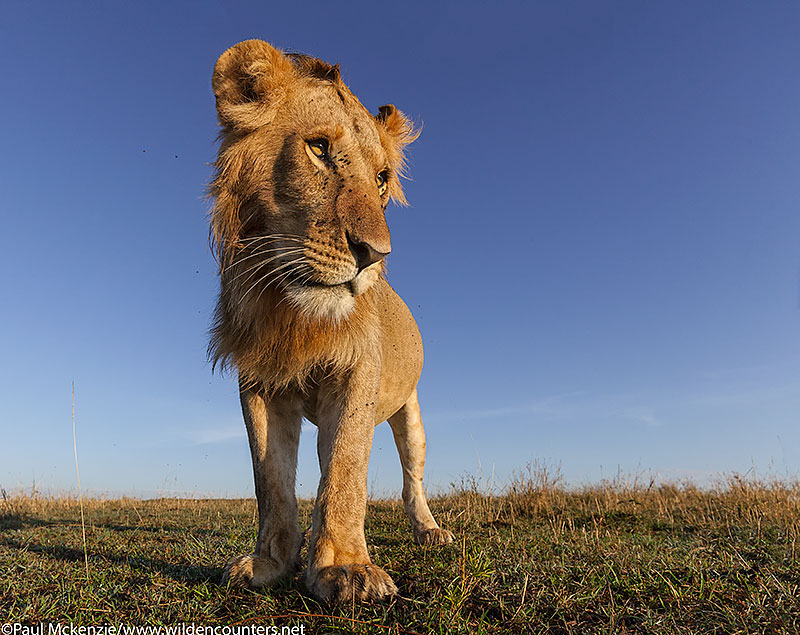
7. Young male Lion, Masai Mara, Kenya
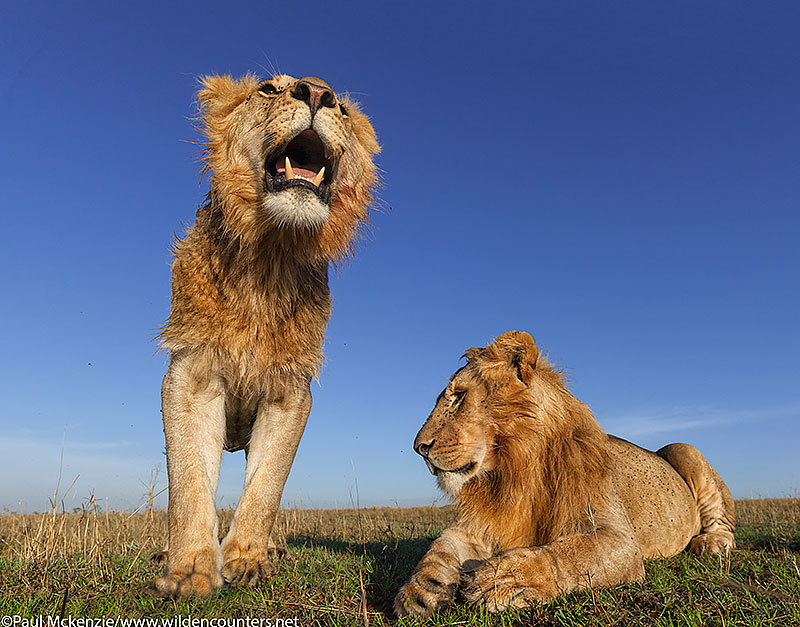
Young male Lions, close-focus, wide-angle, Masai Mara, Kenya
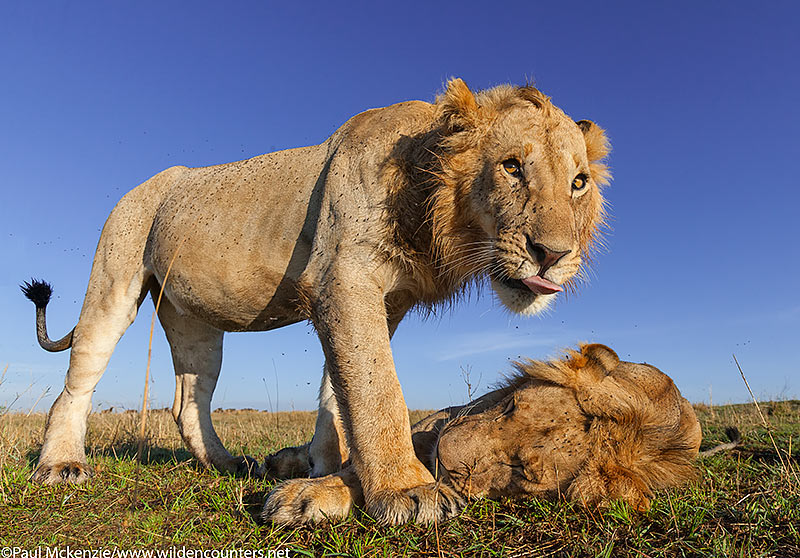
Two sub-adult male lions, close-focus, wide-angle, Masai Mara, Kenya
Once fairly common in the Mara, Wild Dogs were largely wiped out in the 1980s due to disease (distemper). A few still remain, mainly around Aitong in the North Mara but these are rarely seen. Very occasionally, transitory nomads, usually on their way to the Serengeti are spotted and hence it was with some considerable excitement that we received word on the radio one morning during the recent November trip, that a small group of four had been sighted not far from us. We reached the dogs within half an hour and followed them for a good hour as they covered a considerable distance. As the sun rose higher and as temperatures increased, they settled in some bushes where we waited for seven hours hoping that they would eventually emerge and become active. Nature has a way of not co-operating and in near darkness, we left them knowing that the odds of finding them again the next morning would be incredibly slim.
Sure enough, when we returned at dawn, they were gone. We searched for another hour or two but to no avail but then late morning our radio crackled into life with information that they had been spotted about 25kms from where we had last seen them. After a long drive and a good deal of searching we eventually caught up with them as they headed in the direction of the Sand River and the Tanzanian border.
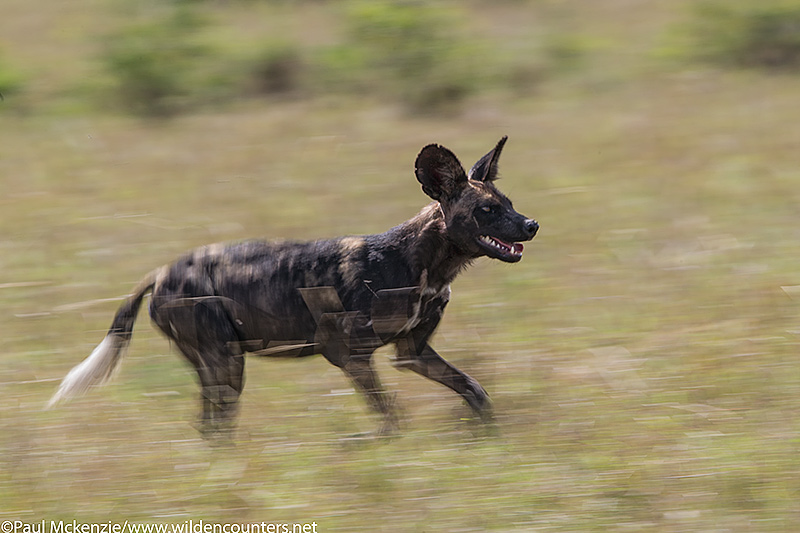
Wild dog running, with motion, Masai Mara, Kenya
Again they bedded down under the shade of an Acacia tree. This time we were completely on our own and unlike the previous day, they would periodically become active. I sent out buggy-cam for an investigative sniff around but unlike the Wild Dogs which are regularly seen in the South African and Botswana parks and which are used to humans and vehicles, these ones were quite skittish and never really came quite close enough.
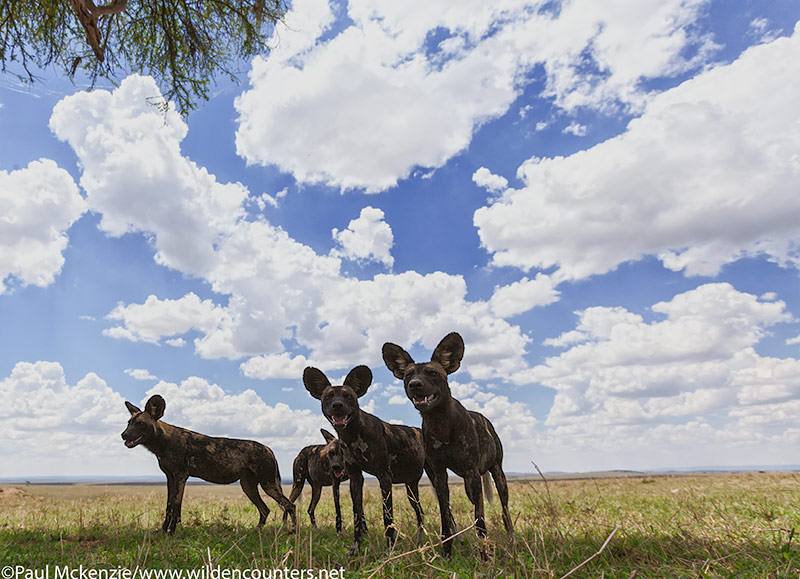
Wild dogs, close-focus, wide-angle, Masai Mara, Kenya
It was also clear that if there was more than one vehicle around that they would become uncomfortable and retreat into cover as was the case late afternoon. However, as soon as the 3-4 other vehicles that had joined us left at around 6.30pm, they immediately got up with the clear intention of hunting. Although we did not see any real predation, it was wonderful to see them so active and comfortable in the close presence of our vehicle. Most encounters with Wild Dogs in Africa are in areas of heavy vegetation so to see them in the open plains was a real treat and an unforgettable experience.
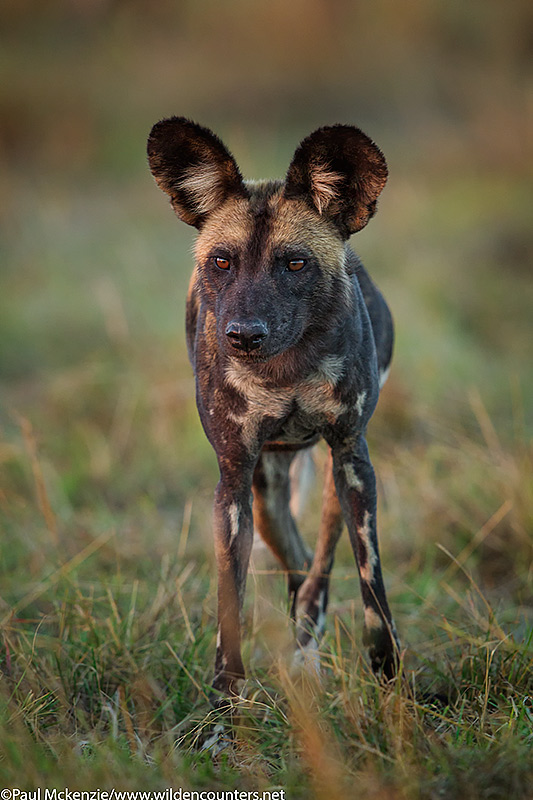
Wild dog, Masai Mara, Kenya
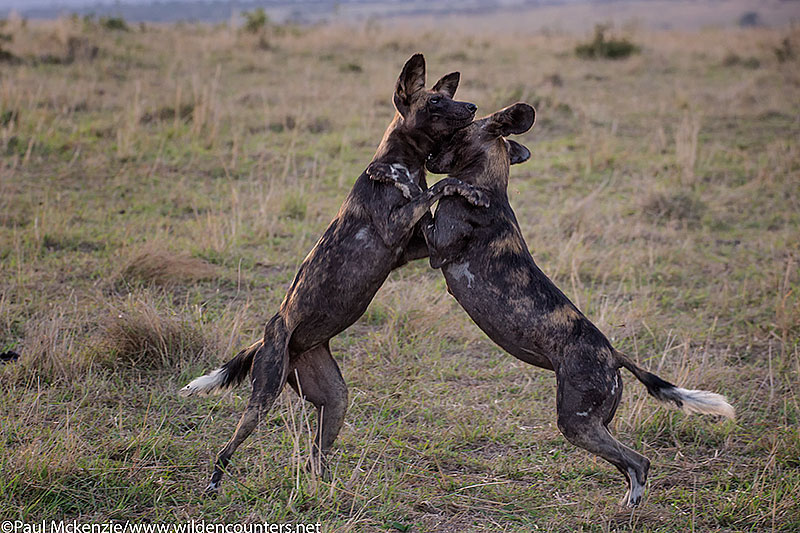
Wild Dogs playing, Masai Mara, Kenya
One of my favorite African animals and one often overlooked by most tourists is the Jackal. The Mara supports a very healthy population of Black-Backed Jackals which in the early mornings and late afternoons are often active around their dens, especially if they have pups. We spent a good deal of time with one family and enjoyed a number of interesting and exciting encounters. The pups were particularly playful in the early mornings affording us some nice photo opportunities.
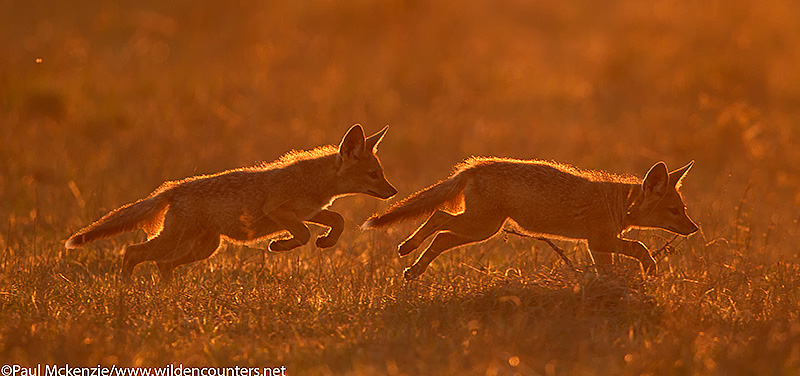
Black-Backed Jackal pups playing, Masai Mara, Kenya
In this image, shot about 30 minutes after the previous image, one of the pups closely investigates two dragonflies.
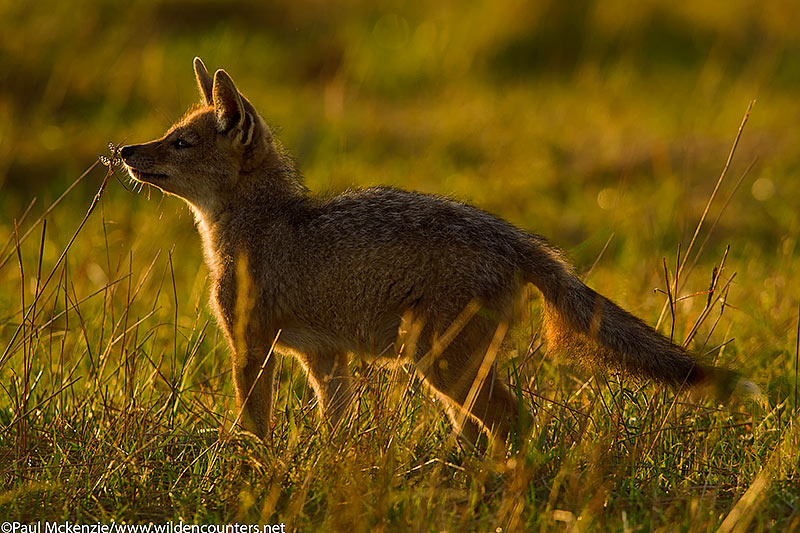
Curious Black-Backed Jackal pup investigating dragonflies, Masai Mara, Kenya
Here two of the pups are on the top of their den at dusk with the one on the right seemingly unbothered by the incessant chewing of its ear by the other.
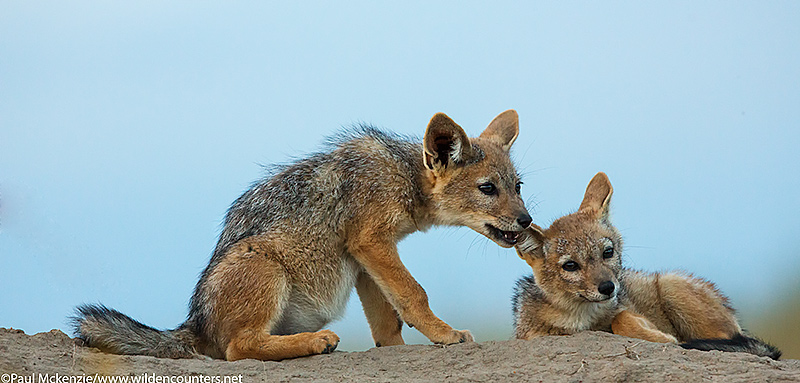
Black-Backed Jackal pups playing on top of their den, Masai Mara, Kenya
Shortly before this image was taken, we were amazed to see one of the parents carrying an African Hare which it had recently killed. It was quite shy when we approached and we had only a fleeting opportunity for pictures before it dropped the kill, so nothing special, but as you can see, this is a pretty big Hare when viewed in the context of the adult Jackal.
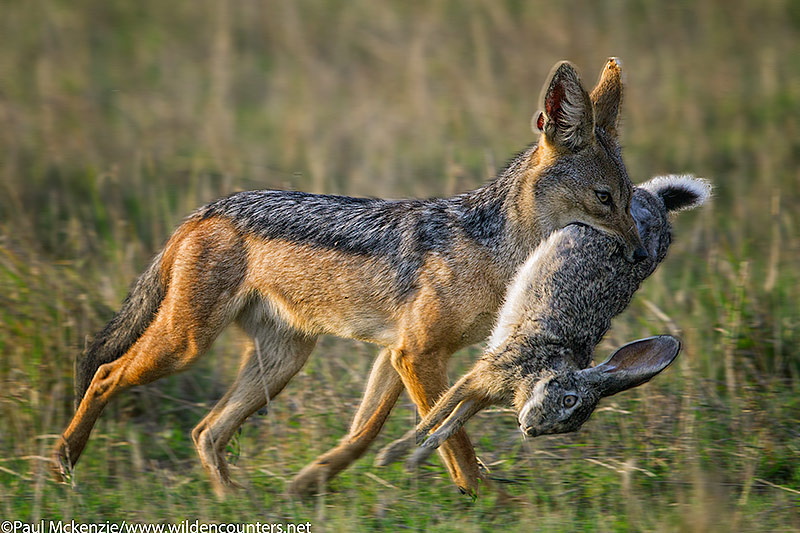
Black Backed Jackal carrying African Hare, Masai Mara, Kenya
The best encounter though was early one morning when we found them on a Wildebeest carcass (probably killed by Lions). Although it was hard to isolate the Jackals, the interaction with the Vultures and the lovely backlighting was fantastic. The Jackals hate the vultures which would grow increasingly bold, edging ever closer to the carcass before being chased at high speed by the Jackals. On numerous occasions the Jackals would catch the Vultures and aggressively bite their wings. The first image represents one of the few occasions that an individual Jackal and Vulture moved away from the main group and it is one of my all time favourites. When I first saw it on the back of the camera I really regretted clipping the Vulture’s wings but now I’m not bothered. The lighting, the action, the flying dew all combine to make this (in my very humble opinion!) a really nice image.
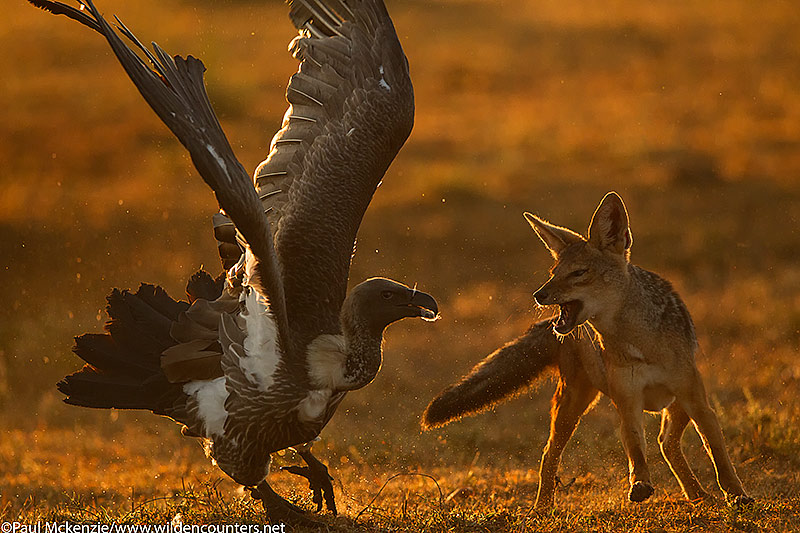
Black-Backed Jackal fighting with African White-Backed Vulture, Masai Mara, Kenya
The next image was taken exactly one second after the above image (3 frames later). While not as dramatic, I like the backlit Vulture wing serving as a frame.
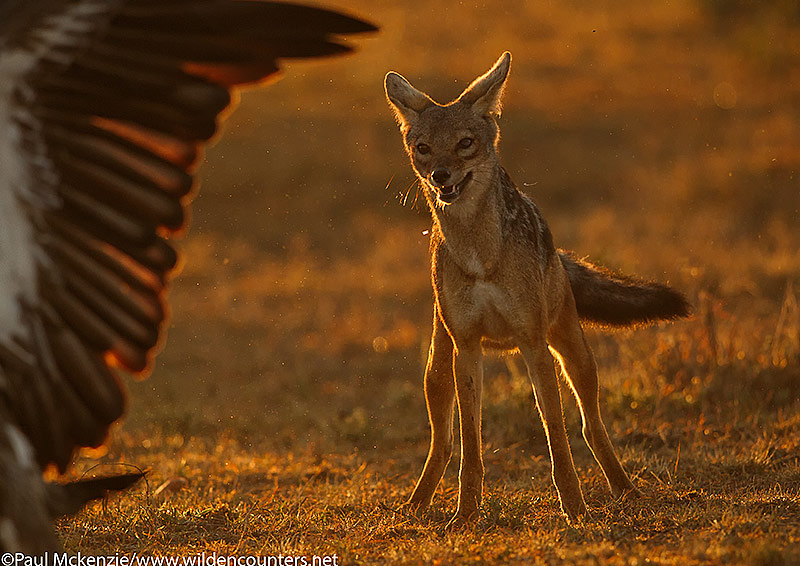
Black Backed Jackal watching fleeing African White-Backed Vulture, Masai Mara, Kenya
But it’s not all one-way traffic and the Vultures can dish it out as well. A bit cluttered but a comical image nonetheless. Ooow!
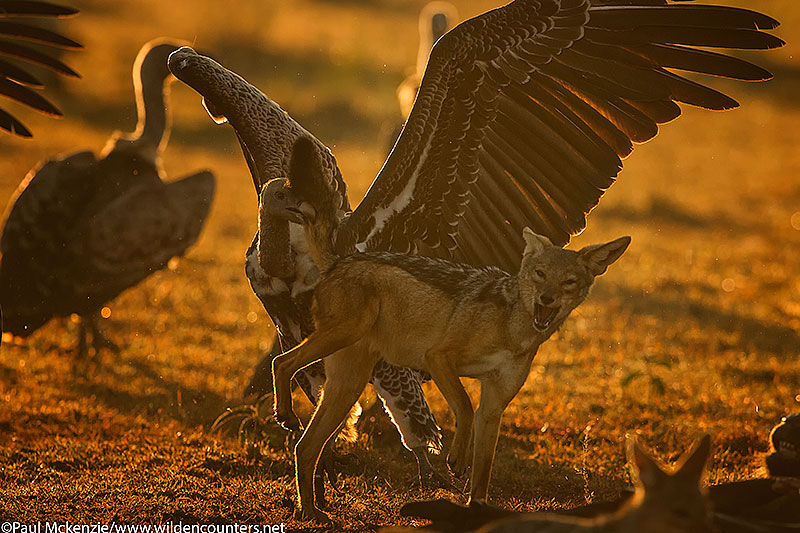
African White-Backed Vulture biting Black-Backed Jackal tail, Masai Mara, Kenya
As the sun rose, we switched around to the other side for more conventional lighting. This is the same Jackal as above, extracting a measure of revenge.
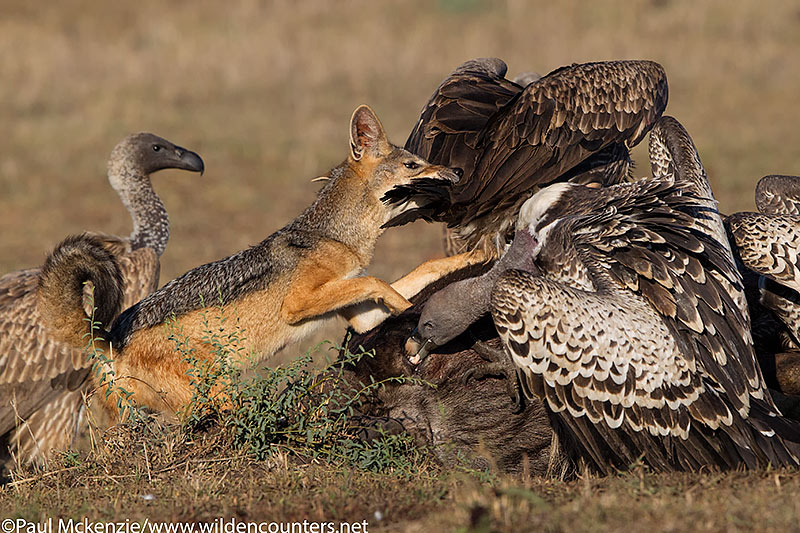
Black-Backed Jackal biting African White-Backed Vulture, Masai Mara, Kenya
Once they had finished terrorizing the Vultures, the Jackals spent a long time playing amongst each other.
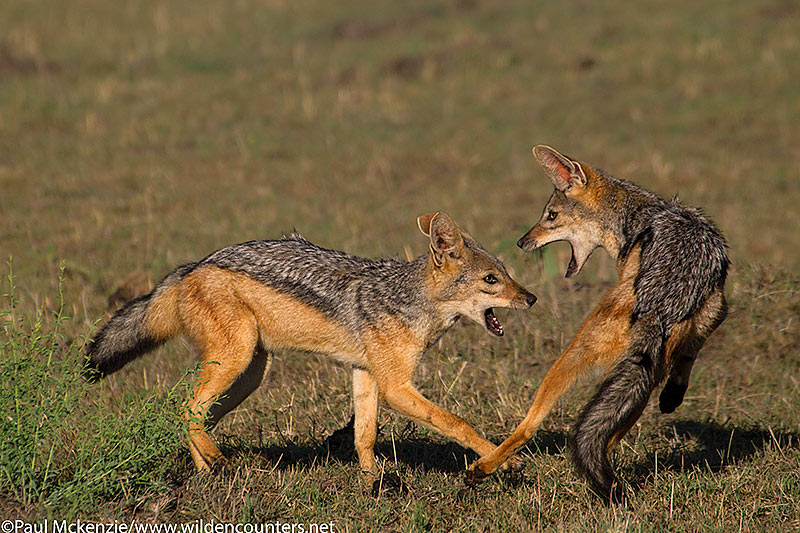
Black-Backed Jackals playing, Masai Mara, Kenya
With so many prides of Lions around it was perhaps surprising that we didn’t spend more time with them but we still had some nice opportunities on a number of early mornings.
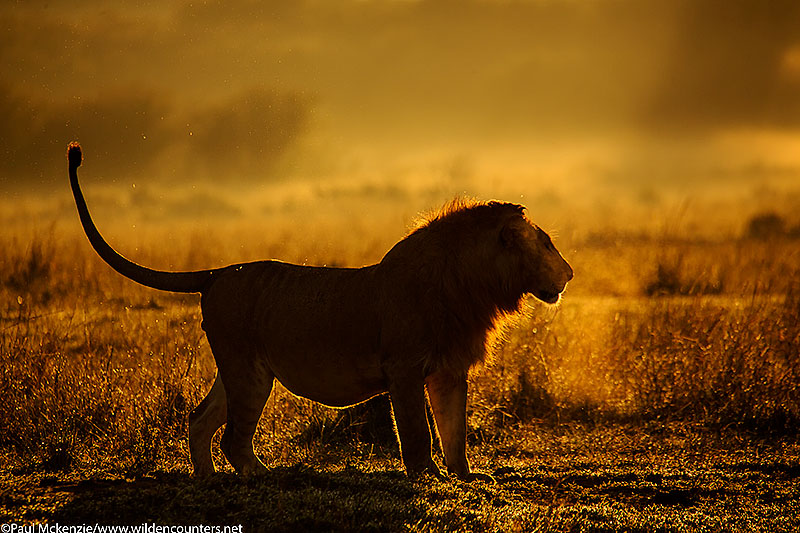
Male Lion backlit at sunrise, Masai Mara, Kenya
This is one of Notch’s sons, also early in the morning.
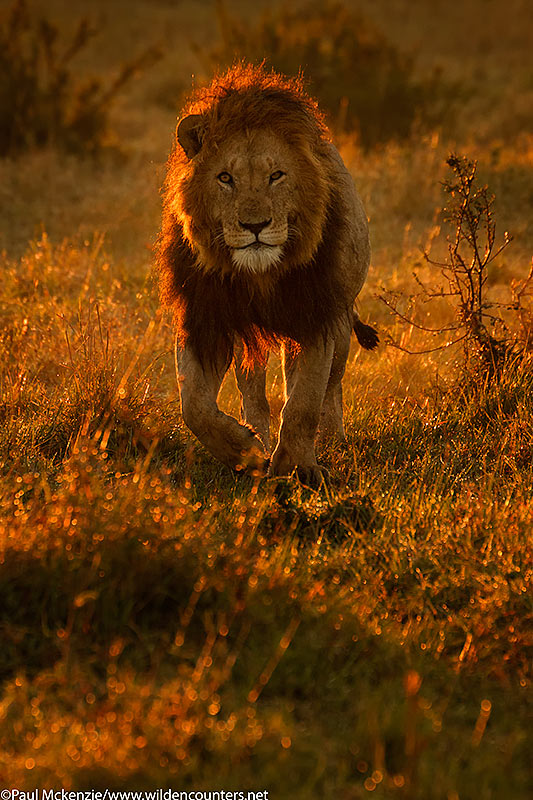
Male Lion, Masai Mara, Kenya
I love photographing in the rain and some of the images that have done best for me in competitions have been taken in rainy conditions. If it rains and you can find male Lions, stay with them because when the rain stops or eases, they will eventually shake their manes with often spectacular results.
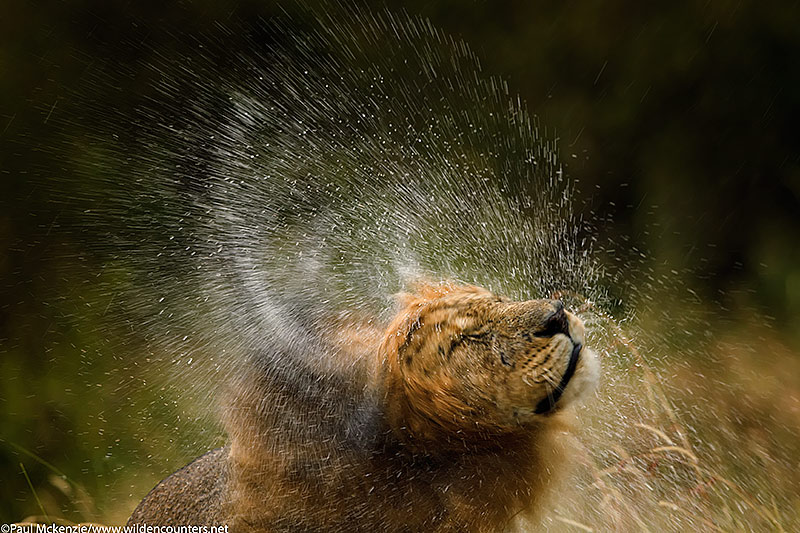
Male Lion shaking wet mane with water spraying, with motion, Masai Mara, Kenya
When I head out each morning in the velvet darkness of the African bush, I usually have some rough plan for what I will concentrate on, at least initially, but I rarely set these plans in stone so that if I chance upon something I’ll often stick with that and abandon my original ideas. I’ve found over the years that operating with only a very rough plan or no plan at all works best for me. While I will sometimes invest long hours (very occasionally days) waiting for a particular species to do something, I will rarely give a second look for instance to a tree dwelling Leopard. I gave up long ago waiting for Leopards to get active especially if there are other vehicles around. I’ve got hundreds of images of Leopards sitting in trees and frankly they do nothing for me and unless one has weeks to spare (no one does), it’s just not worth investing whole days sitting beside trees waiting for them to come down. When the light is good (this includes flat, middle of the day overcast conditions), if there are no iconic subjects around, go for the less obvious as photographically they can be every bit as rewarding. Here’s a good example, shot backlit again and where I waited for the Oxpecker to fly into the frame.
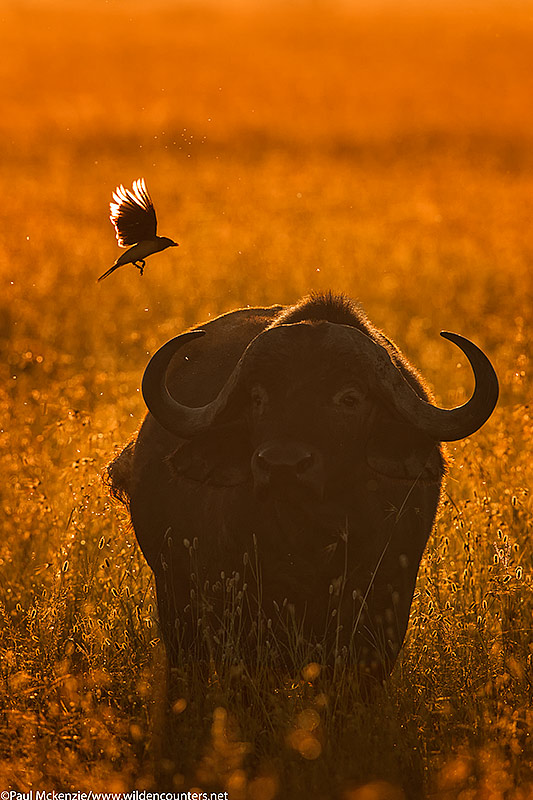
African Buffalo with Oxpecker in flight, backlit in tall grass, Serengeti, Tanzania
Often the most common species are overlooked photographically but I’d much prefer to photograph Zebras than Leopards sitting in trees for instance. On a dreary, low cloud day in May, I spent almost two hours with a 600mm lens and a 2x converter, attempting to make tight images of Zebras concentrating entirely on the patterns of their stripes. I can’t tell you how much fun this was.
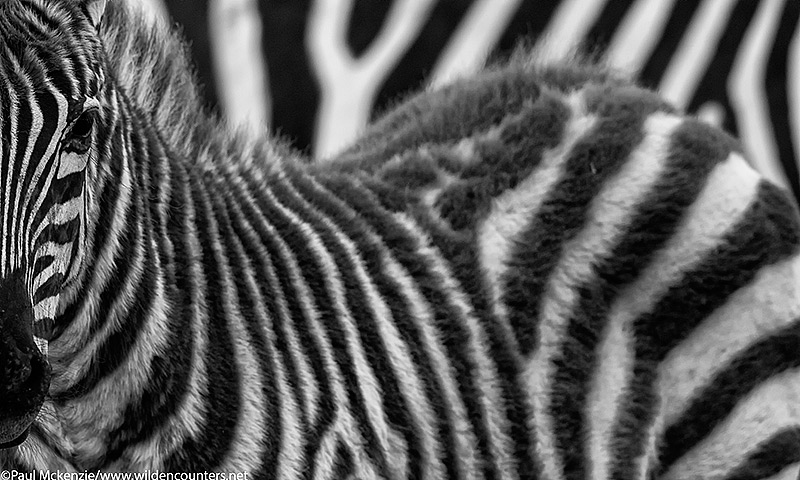
Juvenile Zebra, abstract, Serengeti, Tanzania
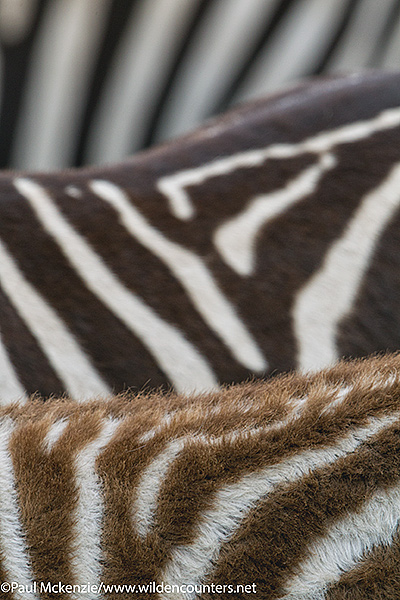
Different generations – Zebra patterns, abstract, Serengeti, Tanzania
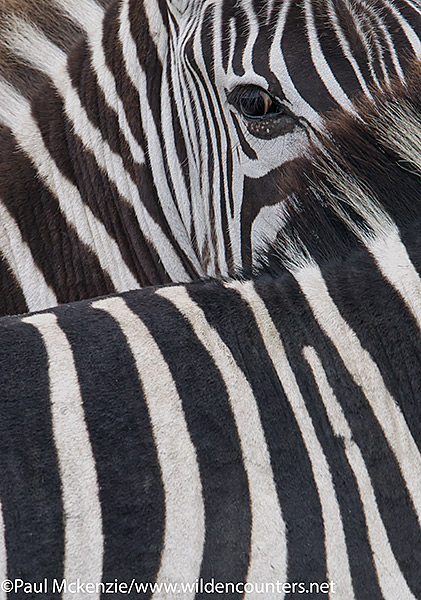
Zebra patterns, abstract, Serengeti, Tanzania
This next one is a little different with an intentionally slow shutter speed used (1/10th sec) to blur the Wildebeest galloping past the static Zebras.
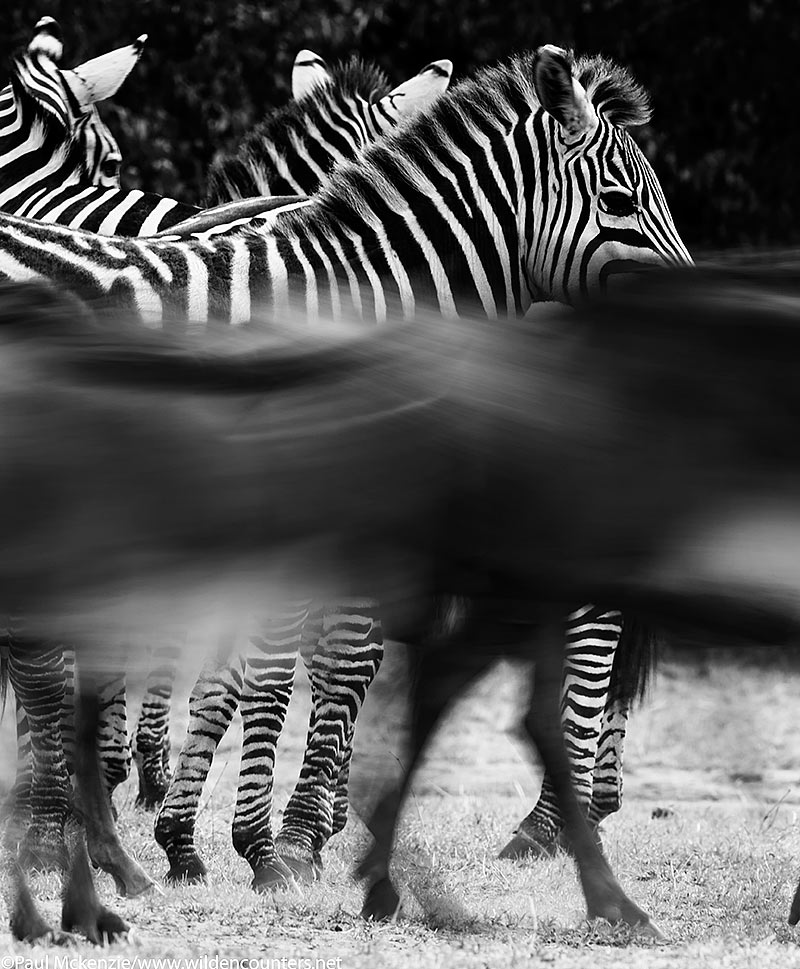
Wildebeest, with motion, galloping past Zebras, Masai Mara, Kenya
Impalas are a super common species and another of my favorites. This one was fleeing from a hunting Cheetah – often it’s a good idea to train your lens on the prey rather than the hunter – and what makes this image for me are the distant undulating hills. Some photographers would probably try to tell you that they specially lined up the hills in the frame but this off course is BS because when an Impala is running at 50mph across open grasslands, all you’re trying to do is keep the subject in the frame – anything more than this and the photographer is in porky pie land. My framing here is just dumb luck but I will say there is some truth to Gary Player’s old adage that “the more I practice, the luckier I get”.
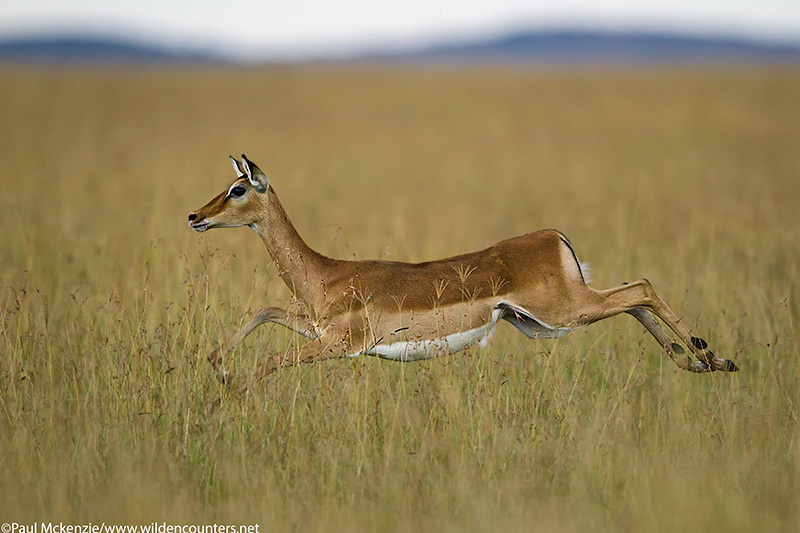
Adult female Impala running across savannah, Masai Mara, Kenya
I love photographing birds so I rarely pass up a chance when I have it. Here are four straightforward images from the 2013 East Africa trips. The first is an African Wattled Plover and I wanted a tight head shot to show off its spectacular facial coloring and the interesting facial wattles and lappets (the folds of skin hanging from the face).
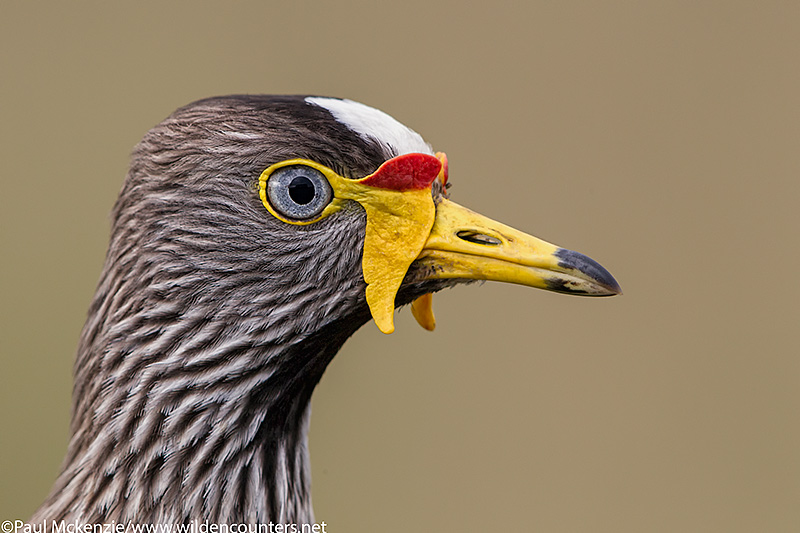
African Wattled Plover head shot, Masai Mara, Kenya
Next up is one of East Africa’s most common birds, the aptly named Superb Starling. Because they spend much of their time on the ground, the only way to photograph them properly is at eye level, lying on the ground.
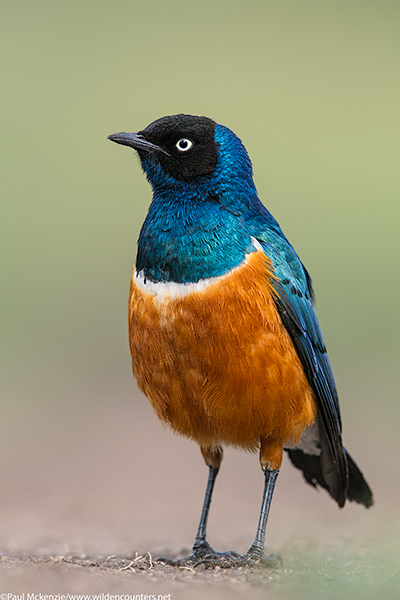
Superb Starling, ground level view, Serengeti, Tanzania
Oxpeckers are another common species that I never tire of photographing. They spend most of their time living a symbiotic existence with Buffalo, Zebra, Impala, Rhino and Giraffe. This Yellow-Billed Oxpecker had cleverly taken refuge on a Giraffe’s leg, using the latter’s body above to shield it from rain that had begun to fall.
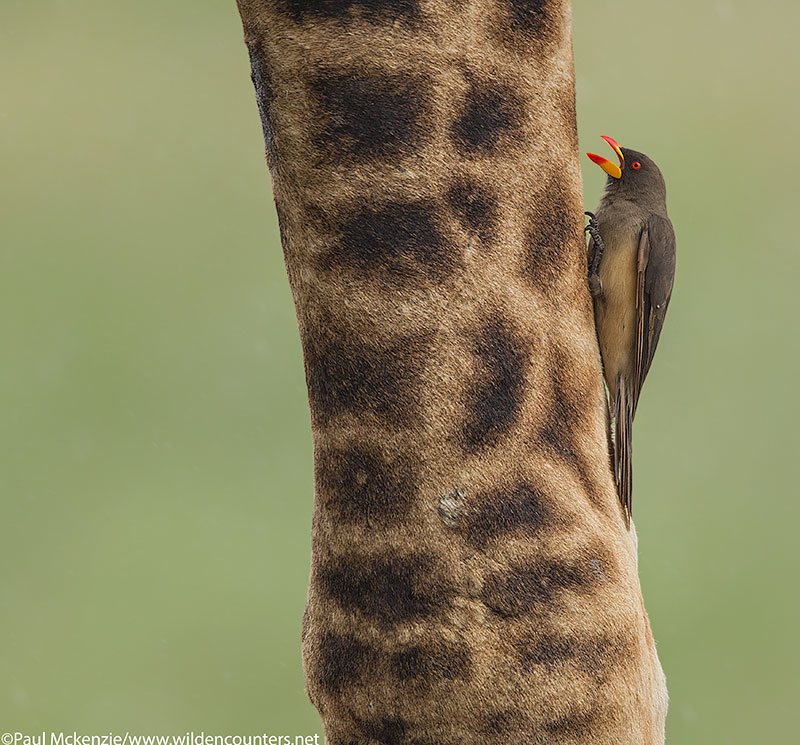
Yellow-Billed Oxpecker on Giraff leg, Serengeti, Tanzania
Lastly, here is a Secretary bird. Again a common species and although you hear lots of stories about them catching snakes, I’ve never actually witnessed the event, until my most recent trip. I wish I’d gone tighter on the head to see more of the snake but it happened so quickly that there was no time to change lens.
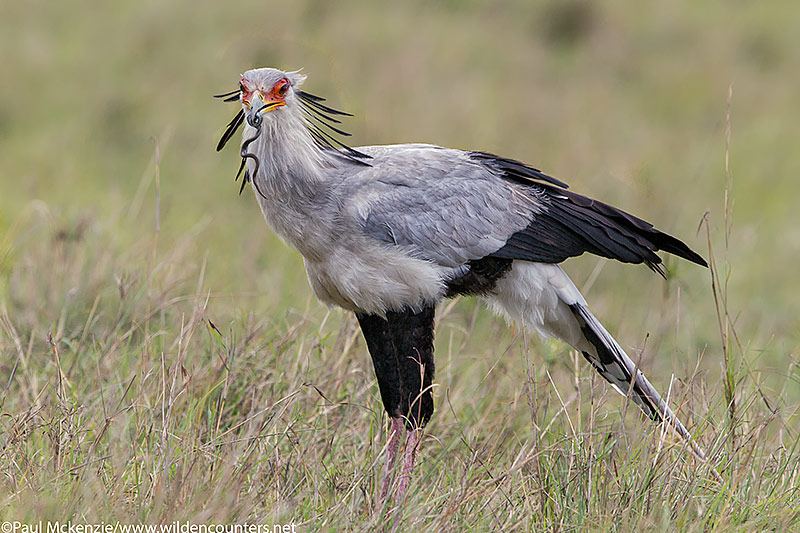
Secretary Bird with snake, Masai Mara, Kenya
In March, we spent quite a bit of time with Malaika, the female Cheetah and her then nearly fully grown male cub. Malaika is well-known as a vehicle climbing Cheetah. In recent months there’s been quite a bit of chatter on the social network pages about the behavior of vehicles/visitors/guides in the presence of Malaika. Some of these threads have been started by fairly well-known photographers and some of their observations are correct and make a lot of sense. For instance, there was a well documented case where some disinterested visitors instructed their guide to drive off while Malaika was still on their roof. This is clearly inexcusable behavior and could easily have resulted in an injury to Malaika and as we all know, any kind of injury that prevents a Cheetah from reaching top speed is a potentially fatal one. I certainly laud the conservation ethos displayed by some of the commentators, but I feel some overstep the mark with some of their suggestions/instructions. One photographer has suggested something along the lines that vehicles should not be within 50-100m of Malaika and if she walks towards a vehicle, that vehicle should immediately drive off. He went onto suggest that vehicles/guides/visitors should be named and shamed if they allow Cheetahs onto their vehicles. For me anyway this is too extreme and I think it also displays some ignorance about the history of the Mara’s vehicle climbing Cheetahs.
In the early/mid-1990s, a camp owner in the Northern Mara found a Cheetah cub near to its dead mother, killed presumably by Lions or Hyenas. Knowing that the cub would be incapable of surviving on its own, he managed to coax it into his vehicle. He subsequently hand-reared it, named it Patel and incredibly was able to teach it to hunt. He would often spend days and nights out on the open savannah with the Cheetah and it developed a habit of often sleeping on his vehicle at night. To cut a long but fascinating story short, Patel (later named Queen or Queenie) became a successful hunter and mother and its vehicle climbing antics have been passed down through subsequent generations of Cheetahs.
While I would not sanction the active solicitation by guides/visitors to entice Cheetahs to climb onto their vehicles, it is important to remember that it is always the Cheetah’s choice whether to climb onto a vehicle. And they typically do so for a reason: to spot potential prey from a higher vantage point. Since the prey do not associate vehicles with feline hunters, being atop a vehicle has the added advantage of surprise. I’ve lost count of the number of times that I’ve seen a Cheetah hunt successfully from a starting position on top of a vehicle.
While it’s a tremendous thrill to have a wild animal in such close proximity I would emphasis that it’s essential to display proper etiquette around the Cheetah. This means very slow deliberate movement; absolutely no touching and if the Cheetah decides to remain for an extended period on the vehicle (rare), then you just have to put up with it regardless of one’s interest level. I’ve had many, many Cheetahs on my vehicle over the years in the Mara starting with Queenie and I feel that I’ve always behaved responsibly around them. Anyway that’s my mini-rant over and I make no excuses for the following images.
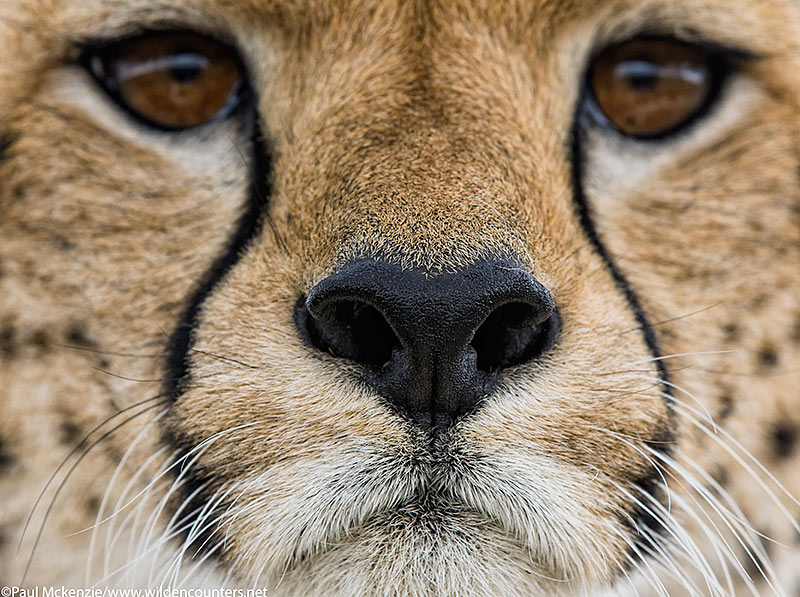
Cheetah face close-up, Masai Mara, Kenya
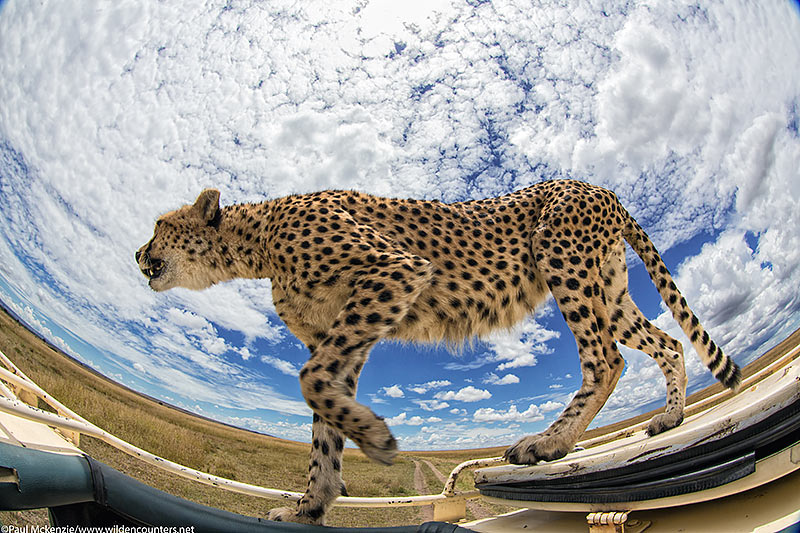
Cheetah walking on vehicle, fish-eye shot, Masai Mara, Kenya
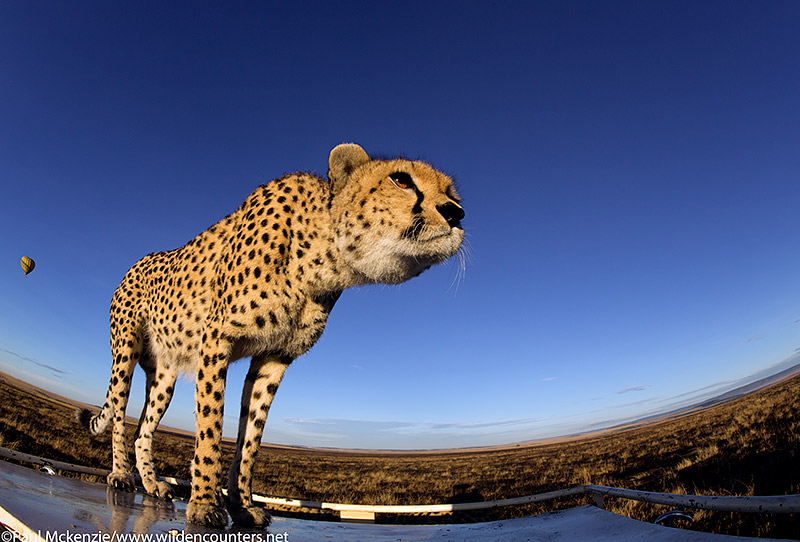
Cheetah standing on vehicle top, fish-eye shot, with hot air balloon in the background, Masai Mara, Kenya
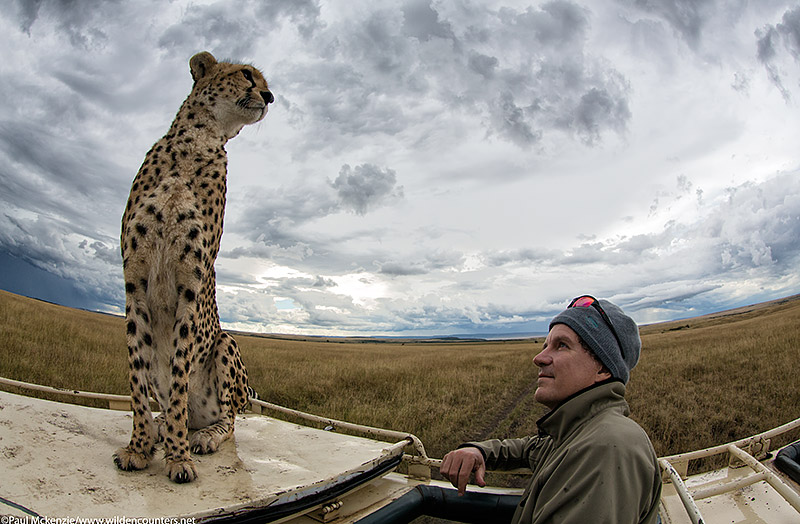
In awe, Masai Mara, Kenya
Staying with Cheetahs but moving away from vehicles, this at first glance looks like a nasty injury but in fact it’s nothing of the sort. Rather this cub has just removed its head from the belly of a Gazelle which it has been feeding on. It even still has tufts of Gazelle fur on its nose.
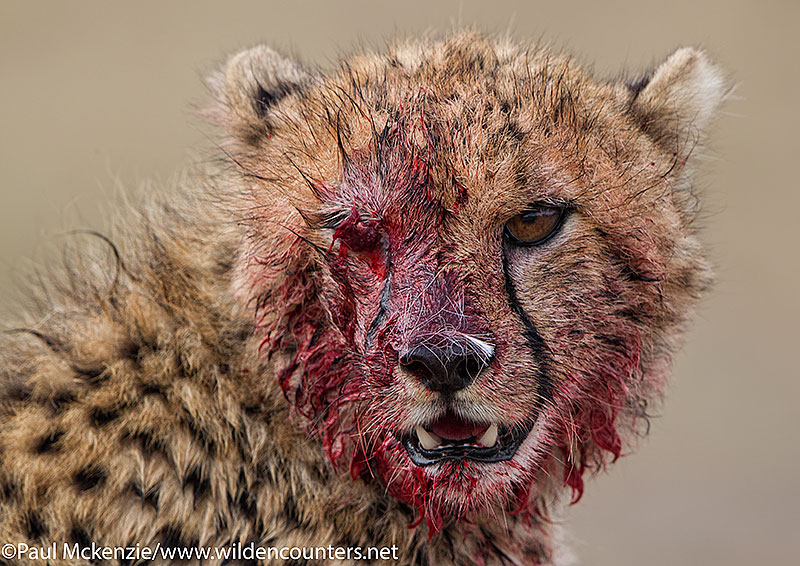
Cheetah cub face covered with blood after feeding on a Thomson’s Gazelle kill, Masai Mara, Kenya
As I’ve written before, my favorite type of photography in East Africa is undoubtably aerial photography. There’s nothing quite as exhilarating as flying with an open door and watching the splendours of the African landscape unfold a few hundred meters below you. And nowhere is this landscape more spectacular than over East Africa’s soda lakes. It’s not cheap and I wish I could afford the stable platform of a helicopter but the small Cessna I use is still fantastic especially with the incredibly skilled pilots that I use. I have been doing this type of photography since 2006 and probably have more than enough good images to fill a decent sized book but here are a tiny selection from my recent trips. Just to give you an idea of what it looks like from inside the plane, here is an image of my good friend and highly skilled/underrated photographer, Michael Viljoen.
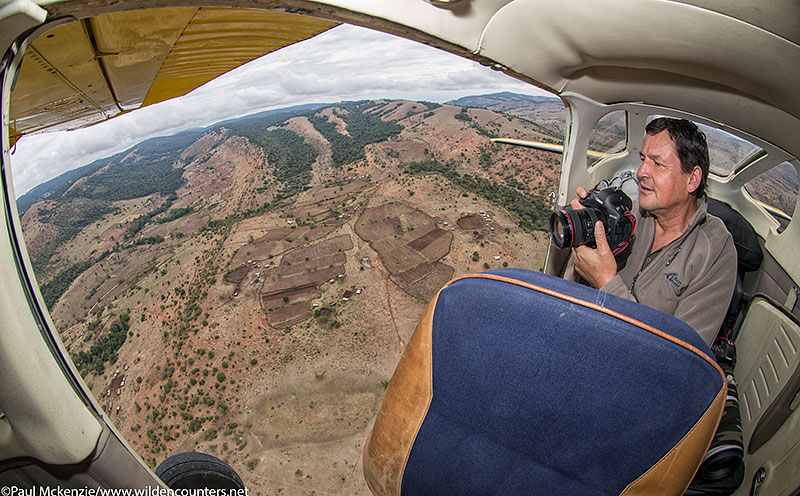
A long way down
This is Lake Bogoria with Lesser Flamingos flying in formation over a huge algae slick. Someone recently pointed out to me that they see the outline of the Americas on the left, the east coast of Africa in the center and India on the right. It’s strange how you can look at an image for a long time and then someone else comes along and instantly sees something you have missed.
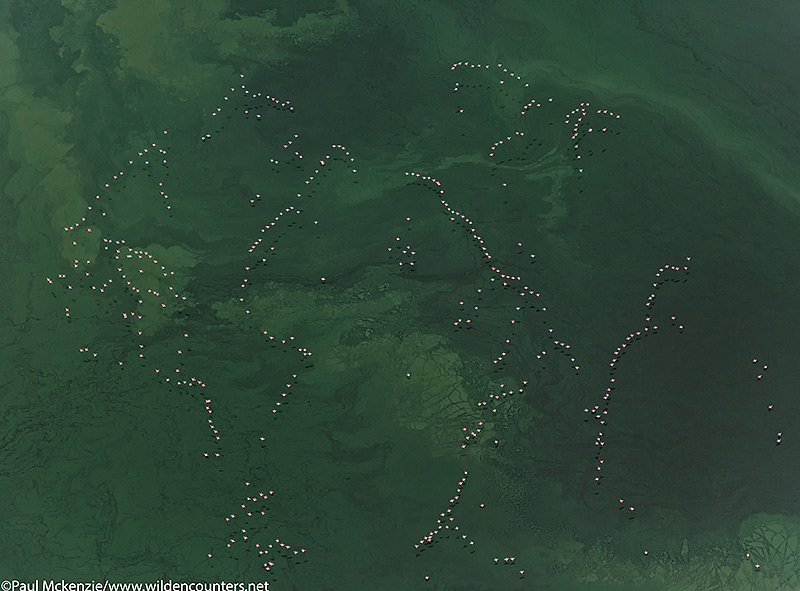
Aerial image of Lesser Flamingos flying in formation over algae slick on Lake Bogoria, Kenya
This is another image from Lake Bogoria. No algae just green waters with the Flamingos arranged pleasingly along the edge of the small island with a Flamingo “tear drop” at the bottom of the frame.
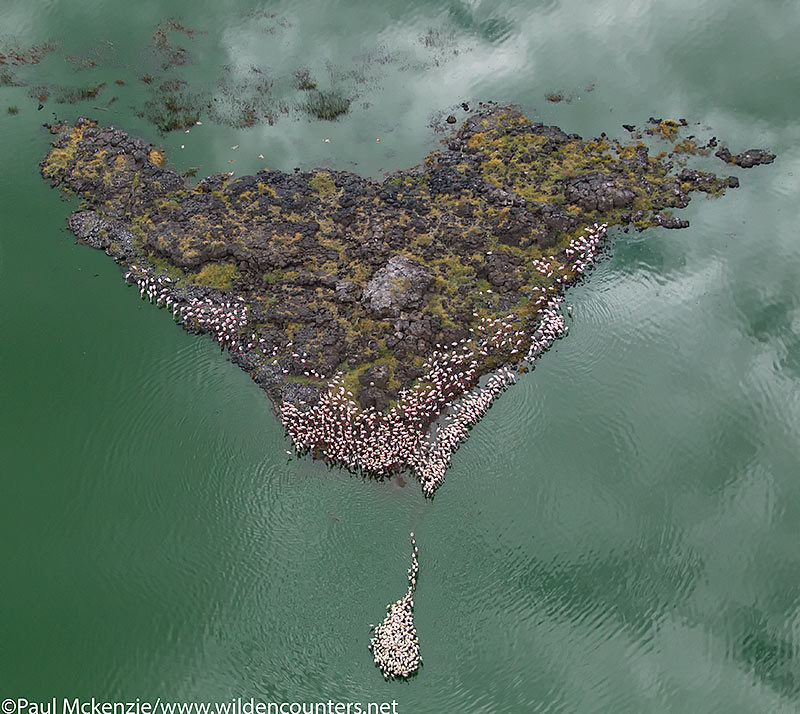
Aerial image of Lesser Flamingos grouped around small volcanic island, Lake Bogoria, Kenya
The Flamingos often gather together in staggeringly large groupings as shown here on Lake Logipi.
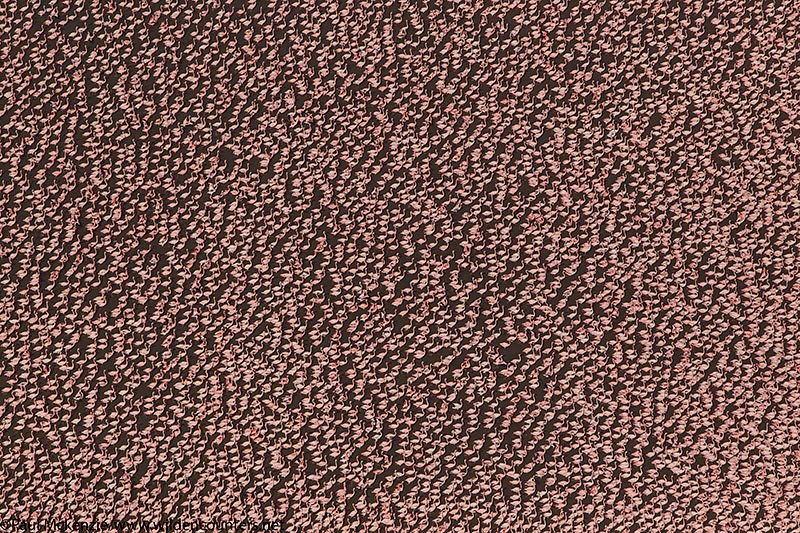
Thousands of Lesser Flamingos grouped tightly together, Lake Logipi, Kenya
Logipi is a seasonal soda lake and conditions are very different every time I fly over it as a result of varying water levels. At one end of the lake lies Cathedral Rock, an ancient volcanic island, around which there are usually a few pools of water in even the driest periods and which in turn, always attract Flamingos.
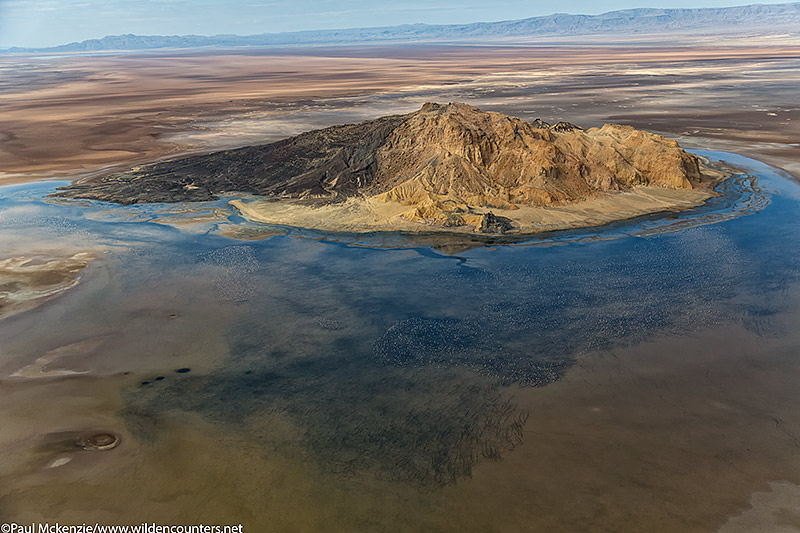
Aerial image of Cathedral Rock in Lake Logipi, Kenya
The furnace-like temperatures on the surface of Lake Logipi means that evaporation rates are high and while the lake can fill quickly when there is rain in the vicinity, it disappears equally as fast. Sometimes fingers of water are formed as the water retreats and the sodium, calcium and phosphate rich waters are an ideal breeding ground for the Flamingos’ staple food source – microscopic algae species.
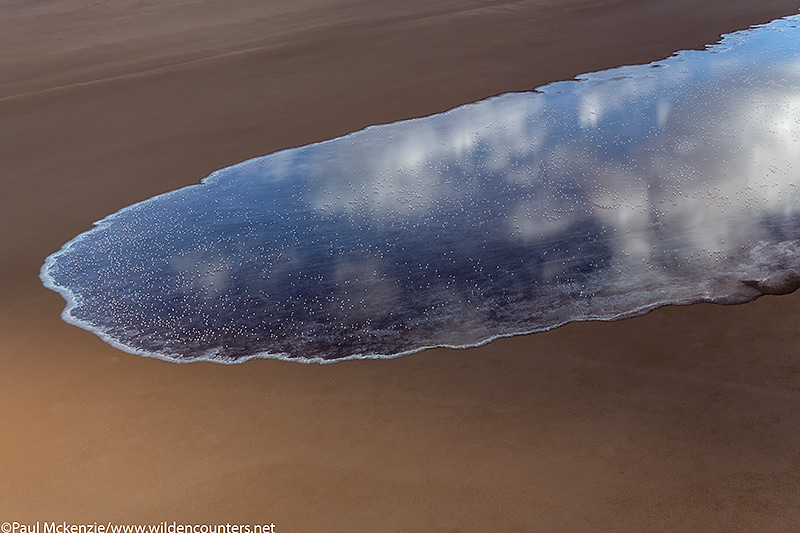
Aerial image of a finger of lake water on dry lake bed, Lake Logipi, Kenya
Even in the deepest areas, the water is never more than a foot or two deep and is usually clouded with a brownish silt. This silt sits above a bed of gooey black/dark blue mud. Flamingos walking across the lake bed leave black trails in the mud behind them and when large numbers move, this gives rise to interesting trail patterns and it was these that I wanted to capture in this next image.
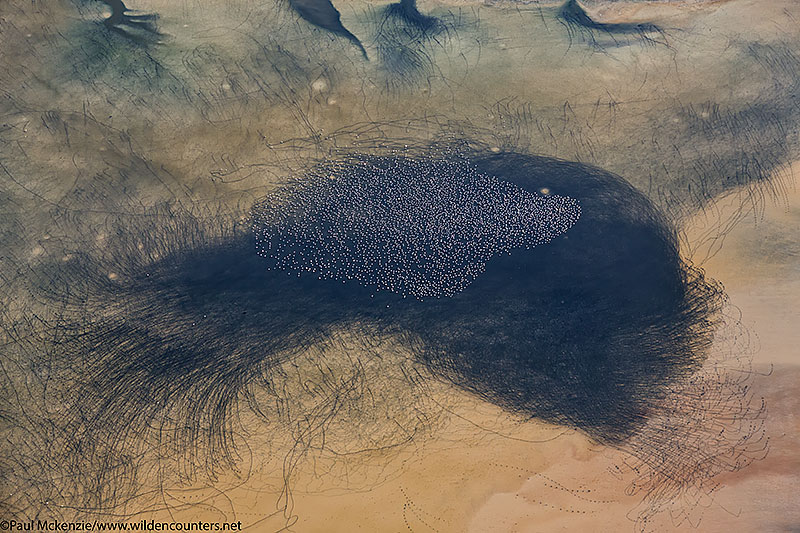
Aerial image of Lesser Flamingos and their trails, Lake Logipi, Kenya
Aerial images of Flamingos flying are nice enough but what makes them extra special over Kenya’s soda lakes is the spectacular backgrounds in terms of the colours and patterns.
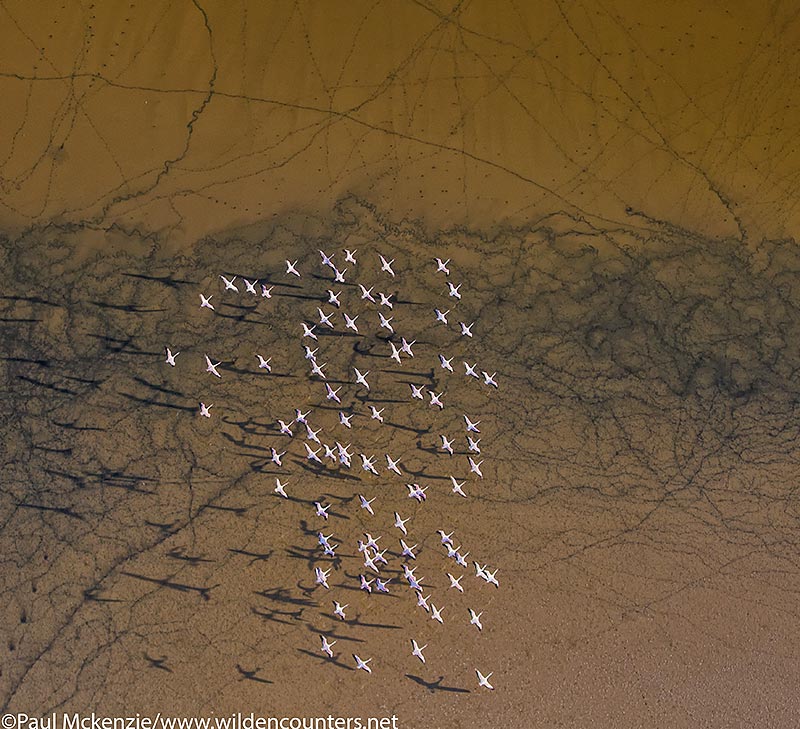
Aerial image of Lesser Flamingos flying over shallow water lake with silt and mud trails visible, Lake Logipi, Kenya
Lake Natron, on the border of Southern Kenya and Northern Tanzania contains some of the world’s truly spectacular landscapes. The Southern Ewaso Ng’iro River rises in the Mau Escarpment, empties into Lake Natron and is the major inflow into the lake. A large and expanding delta along the shoreline mud flat has been formed where the river enters the lake. In the distance, on the top left hand side, you can just make out the periodically active volcano, Ol Doinyo Lengai.
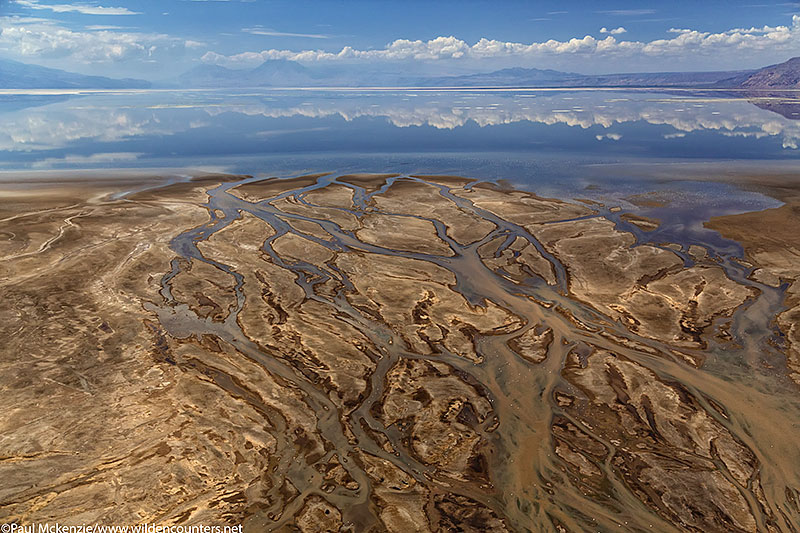
Aerial image of the Southern Ewaso Ng’iro river delta on the edge of Lake Natron, Tanzania
Slightly further inland, Wildebeest and Zebra can occasionally be seen crossing the river. This must be a fairly rare image as I haven’t seen any photos of Wildebeest and Lesser Flamingos in the same frame.
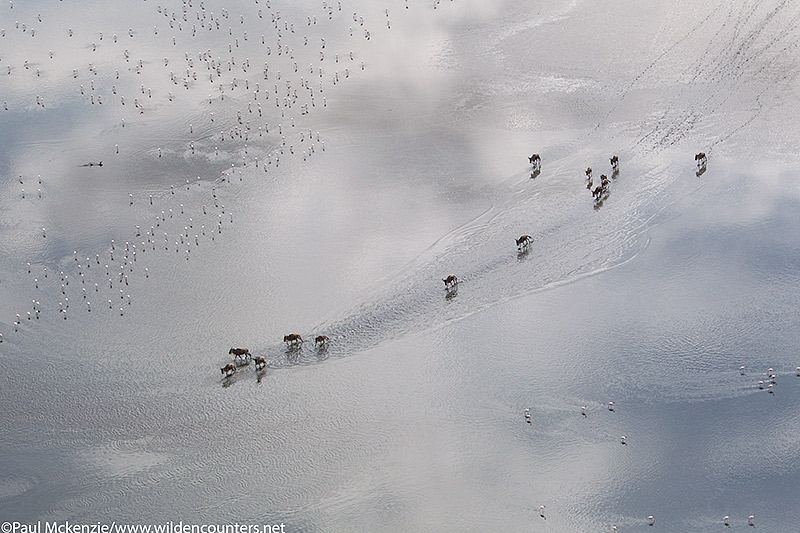
Aerial image of Wildebeest crossing Southern Ewaso Ng’iro river delta, Lake Natron, Tanzania
This next image is another favorite from my trips with the mud trails left by the Flamingos helping to inject an artistic element into a nice natural history image.
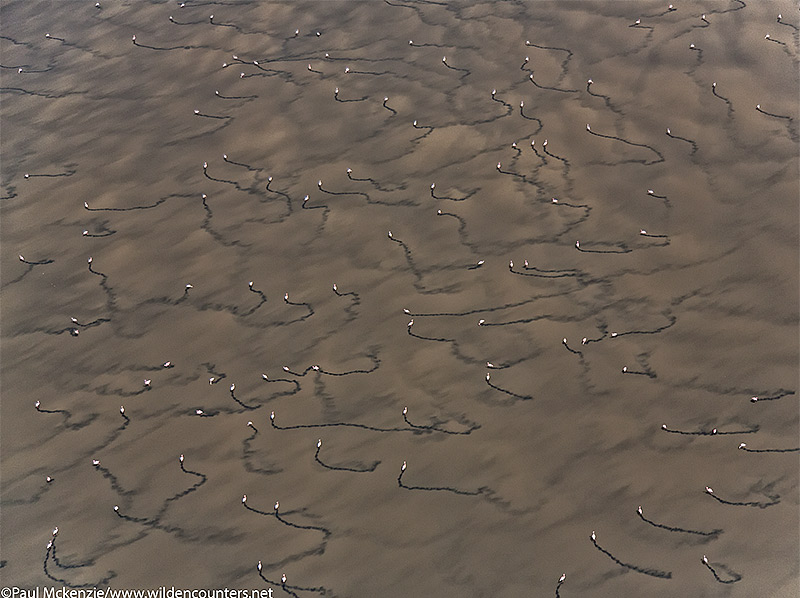
Aerial image of Lesser Flamingos and trails through shallow water soda lake, Lake Natron, Tanzania
If an abstract painter was ever short of inspiration, then my strong recommendation would be an aerial trip over Lake Natron, much of which resembles the surface of another planet and where nature really does imitate art.
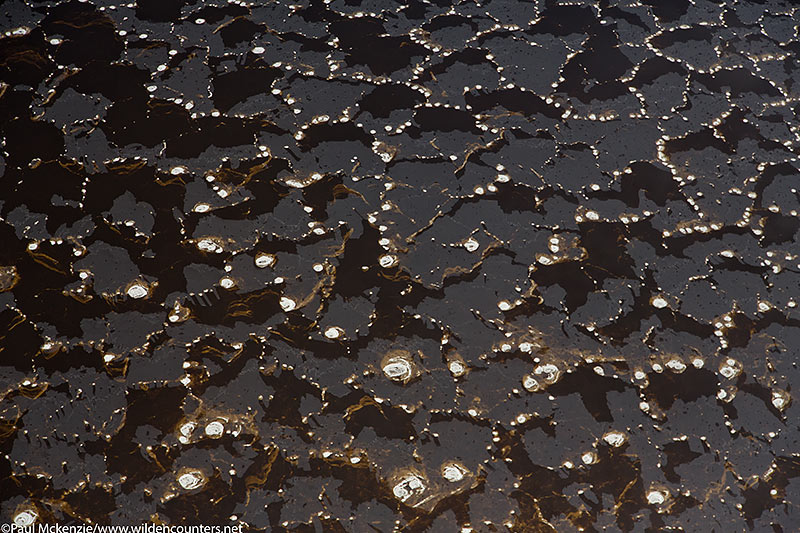
Lake bed, Lake Natron, Tanzania
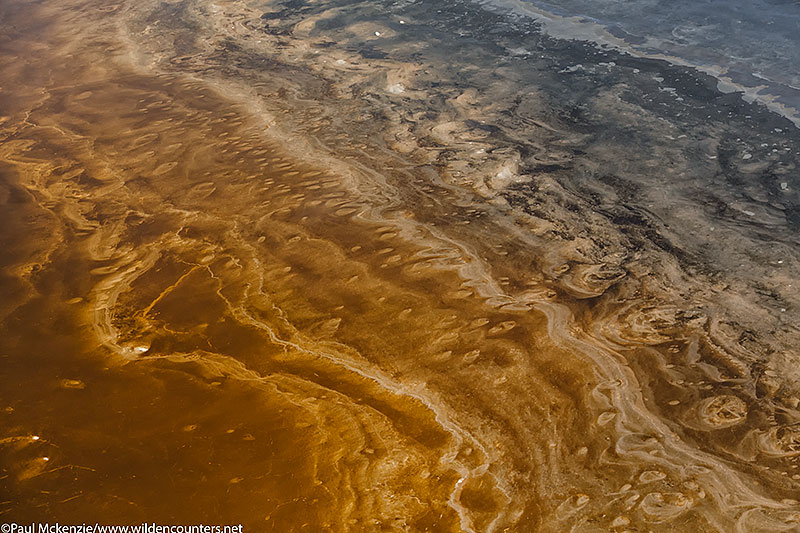
Lake bed #2, Lake Natron, Tanzania
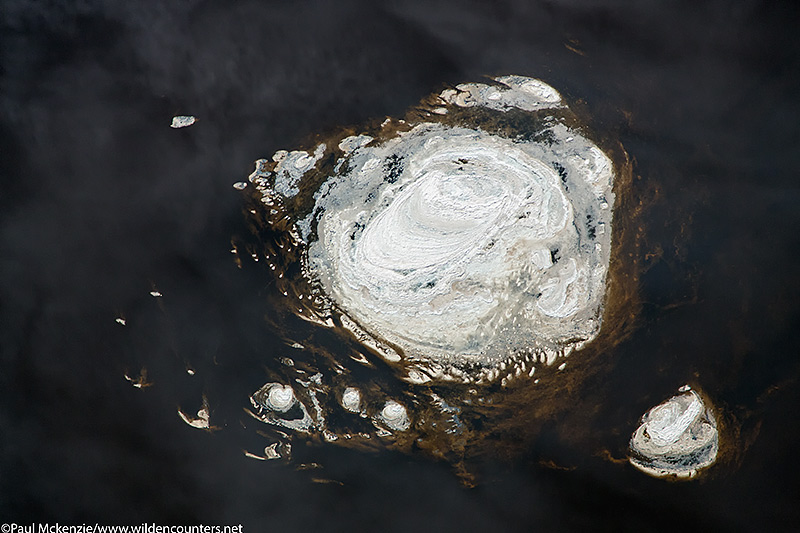
Naturally occurring mineral deposits of sodium carbonate, sodium bicarbonate, sodium chloride and sodium sulphate on the shallow water lake bed of Lake Natron, Tanzania
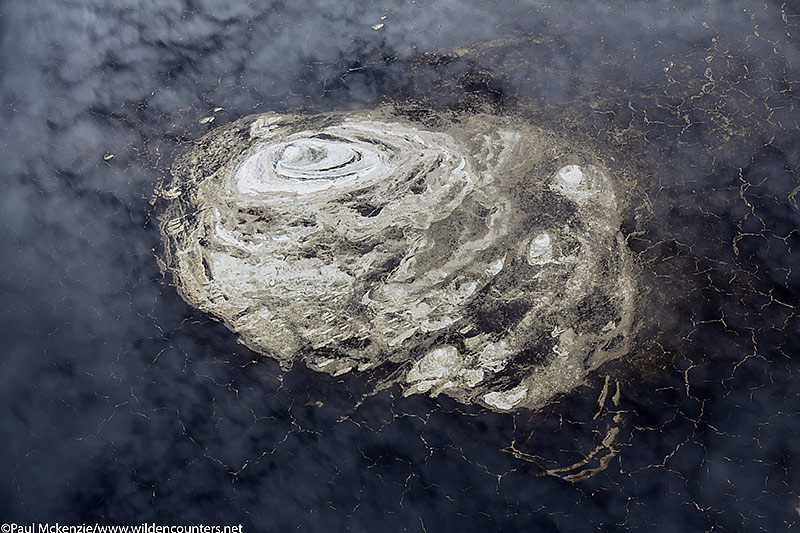
Naturally occurring mineral deposits of sodium carbonate, sodium bicarbonate, sodium chloride and sodium sulphate on the shallow water lake bed of Lake Natron, Tanzania
For the final image, I’m not even going to try and explain what’s going on here. Just sit back and enjoy. Makes me want to get out some brushes and canvas.
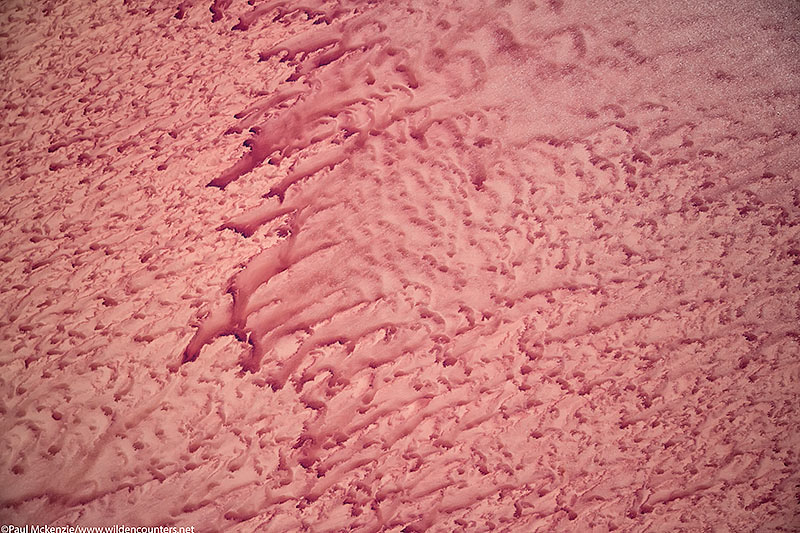
Lake bed patterns, Lake Natron, Tanzania
Beryl McKenzie
December 18, 2013
Absolutely fantastic! What a trip!
Osvaldo Larrain L.
December 18, 2013
Extraordinary photos , different and original , top quality .
The best for you .
Paul Mckenzie
December 20, 2013
Hi Osvaldo, thanks for your generous praise. Hopefully, I will get down to South America in 2014 or 2015.
Arthur Morris
December 18, 2013
Creative and great as expected. See you in Japan in winter. artie
Paul Mckenzie
December 20, 2013
See you soon Artie. Am in Switzerland right now. No real photography. Hoping to dust off my snowboarding skills.
Breu Lydia
December 18, 2013
Asante sana for These nice wonderful Picture. Lydia
Paul Mckenzie
December 20, 2013
Thanks for your kind words. Happy holidays, Paul
Clemens Vanderwerf
December 18, 2013
Paul, as always I greatly enjoy reading your stories and images and this time you did it again. There are some really nice jewels here that are really top notch and creative. I like the multiple exposure image of the wildebeest legs and the three generations of zebras a lot. Great stuff. Keep up the good work. Best, Clemens
Paul Mckenzie
December 20, 2013
Thanks Clemens. We must try to do another trip together sometime. Am in Switzerland right now.
Nilla Stennes
December 19, 2013
I consider it a true privilege to view your photos and read your blog.
Such talent – simply marvelous! Dankeschön !!!
Nilla
Paul Mckenzie
December 20, 2013
Thanks Nilla. Wishing you and your family a very happy Xmas.
grace hung
December 19, 2013
Spectacular photos. Very much enjoyed the photos and reading the accompanying stories. My favourite out of this collection is the oxpecker and African buffalo shot. Grace
Paul Mckenzie
December 20, 2013
Thanks Grace. Interesting choice of favorite. As I mentioned in another reply, it’s always interesting how viewers almost inevitably have different favorites. This is why photo competitions are always a bit of a lottery.
Hilary Hann
December 19, 2013
Worth waiting for this blog Paul, some wonderful photography. I like your summation of the vehicle climbing cheetahs as I too, have felt uncomfortable with some of the social networking ‘name and shame’ antics and I think you’ve made a valid counter point.
Love the aerials as always. I recently took some aerials of Lake Bogoria and when I examined them at home found 2 wild dogs on the banks of the lake. A wonderful surprise.
Paul Mckenzie
December 20, 2013
Thanks Hilary. Wow, Wild Dogs with Flamingos would be pretty unique.
Gordon Lindsay
December 19, 2013
Paul this is certainly worth the wait your narrative reports are always a joy to read and the images! wow, difficult to choose amongst them but I am in awe of the monochrome shot “Wildebeest herd running, Masai Mara, Kenya”.
Thank you very much for sharing with us.
All the very best for 2014.
Gordon
Paul Mckenzie
December 20, 2013
Thanks Gordon. Always difficult to chose a favorite and it’s always interesting how it varies from individual to individual.
Osvaldo Larrain L.
December 20, 2013
It^s your house , I¨ll be with be when ever you come , your always welcome , just let me know .
Anne Owen
December 26, 2013
Paul once again, you have produced a portfolio of outstanding technical quality and superb range of creativity. Inspirational!
Michael Viljoen
December 26, 2013
Hi Paul,
Congratulations Paul – beautiful shots. Beetle- cam produced a few nice surprises as well.
All the best for 2014 – may it be a big photographic year.
Regards
Michael
Paul Mckenzie
December 30, 2013
Hi Michael. Stay in touch about possibly doing something in the 1Q of 2014. Really enjoyed the trips with you in 2013.
Gail Bisson
March 18, 2014
What an incredible series of images. I am a fan!!!
Paul Mckenzie
March 27, 2014
thx so much Gail. I am a fan of your stuff from the birdphotographers site!
Julianna SALMON
April 10, 2014
you are so lucky seeing this wild dogs in Masï Mara!
thank you for all this marvellous pictures.
I continue my visit….